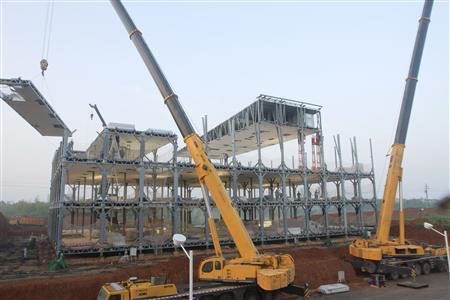Are China's "instant" buildings too good to be true?
Published by MAC on 2012-05-22Source: PlanetArk
At first sight the scheme ticks a lot of boxes. But are they too good to be true?
China is dogged by a "building bubble" which, according to some observers, threatens the country's economic stability. See: Fears of China: a summing-up
Now, a domestic company is delivering pre-fabricated buildings which, it claims, reduces waste, enhances worker safety, conserves energy, and safeguards the environment.
All of this can be achieved in days, rather than weeks or months.
Nonetheless, the raw materials for these building "blocks" are neither traditional nor based on sustainable rates of extraction.
Rather, they depend on inputs of concrete and steel - and indeed upon an increase in the latter. This is hardly a recipe for reducing iron and steel output which the authorities have been urging of late.
In his laudable quest to "truly safeguard humanity", the company's founder says his "instant" constructions will safeguard against disasters such as the 2008 earthquakes, which resulted in the collapse of numerous buildings, killing scores of thousands of people.
Surely, a building which goes up in record time may also be toppled just as quickly?
China "Instant Buildings": Just Add Labor, Fireworks And A Cow
By Terril Yue Jones
PlanetArk
15 May 2012
As a crane lowered a steel-and-concrete slab onto support pillars, construction workers swarmed around to bolt it down - a choreography of mad-dash steps against a backdrop of firecrackers, and a sacrificed cow, to herald China's latest "instant building".
 |
| A view of the three-storey D3 cafeteria under construction by the Broad Group in Yueyang. Photo: Broad Group/Handout |
The three-story structure, a workers' cafeteria, was just a side note to a 30-story hotel built over 15 days outside this city in Hunan province in December. Both are examples of the streamlined construction being pioneered by China's Broad Sustainable Building (BSB).
"There is an urgent need for construction security, especially energy-saving in construction, and this touches on conserving materials," Zhang Yue, Broad Group's founder and chairman, told Reuters in an interview at his headquarters in Changsha.
Over the last decade China has seen one of the biggest construction booms in history to house a surging urban population and an expanding industrial sector. But with that construction have come worries about environmental destruction, waste and shoddy buildings.
Zhang argues that his buildings represent just the opposite.
The subsidiary of Hunan-based cooling systems maker Broad Group finished the T30 Hotel in record time, a feat captured in a time-lapse video that has garnered nearly 5 million views online.
Zhang said he had been appalled at how many poorly constructed buildings collapsed in the 2008 earthquake in Sichuan province that left more than 87,000 dead or missing.
"To truly safeguard humanity, and guarantee we live in security, regardless of where, structures should be all-steel construction," said Zhang, a spry, intense man in his early 50s.
Prefabrication has long been studied but not widely implemented in commercial buildings, says Steven Moore, professor of sustainable design at the University of Texas.
But despite an image of assembly-line flimsiness, "prefabrication can contribute to higher-quality construction, which in turn improves efficiency with less energy consumption," Moore said.
"What I find interesting about what they're doing is that they're now becoming almost like automobile makers," by adapting prefab techniques to construction, Moore said in an interview.
"It's not exactly surprising to me that this round-the-clock, rapid construction system would emerge first in China," said Moore, pointing to China's regulations are less stringent regarding worker safety and overtime pay than in the West.
Broad's use of non-electric chillers powered by natural gas and waste heat is a significant step for greater energy efficiency, he added.
Easy to Learn
"It's very easy to learn the construction - all the workers need to do is fasten the bolts," said Liu Zhijian, a 23-year-old site worker from the nearby city of Loudi.
"There's no welding, no dust, no water," he said. "It's not at all like traditional construction, which is all about bricks and concrete."
The process keeps costs down as well, about 4,000 yuan ($635) per square meter. At 4,500 square meters, the cafeteria comes to 18 million yuan ($2.8 million). Broad says that is up to 30 percent cheaper than conventional buildings.
The approach is relatively straightforward. Workers prefabricate flat modules at two factories in Yueyang, about 90 minutes north of the provincial capital of Changsha.
The tops of the modules, the largest of which measure about 4 x 15 meters, are covered with flooring. On the undersides, forming the ceiling of the floor below, air and water pipes are pre-installed, to be connected once the modules are in place.
BSB estimates it produces 90 percent of its buildings in the plants.
The process also leaves little trash behind.
"We have only 1 percent of construction waste at building sites," said Shang Dayong, a worker from Ningxia province who came to learn the quick-build process to teach others back home.
"With these buildings, we can tear them down and rebuild them somewhere else."
Ningxia is also vulnerable to earthquakes, so BSB buildings have extra appeal, Shang said. BSB claims its structures can withstand earthquakes up to magnitude 9.0 - similar to the devastating quake that hit northeast Japan last year.
Zhang has bigger plans. He has his eyes on a 50-storey quick-build structure in the near future and is seeking investors for a 220-story behemoth in Yueyang.
"We realized we must build very, very tall buildings in order to protect the Earth," he says. "We must reduce our dependency on roads and transportation."